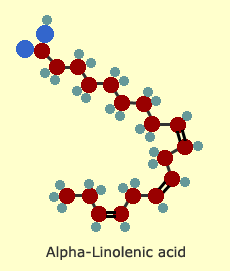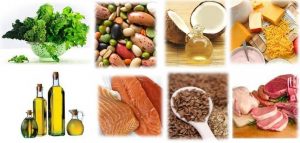Supplement to “Organic Production Enhances Milk Nutritional Quality by Shifting Fatty Acid Composition: A United States-Wide, 18-Month Study,” published in PLOS ONE, December 9, 2013
Authors: Charles M. Benbrook, Gillian Butler, Maged A. Latif, Carlo Leifert, and Donald R. Davis
- Click here to download this primer as a pdf
Introduction to Cow’s Milk
 Whole cow’s milk averages about 88% water, 3.3% fat, 3.9% protein, 4.8% carbohydrate, and it contains small amounts of many other nutrients. Milk is an excellent source of protein, health-promoting omega-3 fatty acids, and many vitamins and minerals, including calcium, potassium, phosphorus, magnesium, zinc, selenium, vitamins A, D, and B12, and riboflavin.
Whole cow’s milk averages about 88% water, 3.3% fat, 3.9% protein, 4.8% carbohydrate, and it contains small amounts of many other nutrients. Milk is an excellent source of protein, health-promoting omega-3 fatty acids, and many vitamins and minerals, including calcium, potassium, phosphorus, magnesium, zinc, selenium, vitamins A, D, and B12, and riboflavin.
According to the 2010 Dietary Guidelines for Americans, milk contributes to bone health, reduced risk of cardiovascular disease and Type 2 diabetes, and lowered blood pressure.
Nearly all of the fat in milk consists of fatty acids—about 93.3% to be precise. The rest of milk’s total fat content is mostly glycerol, cholesterol, phosphate, and other hydroxyl-containing substances. The fatty acids can be saturated, monounsaturated, or polyunsaturated.
The Dietary Guidelines for Americans recommend three daily servings of dairy products (in the form of milk, cheese, and/or yogurt) for people age 9 and older; 2.5 servings for children 4–8 years old; and 2 servings for children 2–3 years old.
The Guidelines are based mostly on meeting calcium needs, and they recommend reduced-fat milk products in order to limit saturated fat intake. In recent years, however, several studies have reported health benefits associated with full-fat milk, despite its saturated fat content. The omega-3 fatty acids in whole milk are a likely source of these benefits.
About Omega-3 and Omega-6 Fatty Acids
 Fatty acids contain long chains of carbon atoms, commonly 14 to 22. Omega-3 (ω-3) and omega-6 (ω-6) fatty acids are polyunsaturated, meaning they have two or more unsaturated bonds along their chain. Both ω-3 and ω-6 fatty acids are essential nutrients. As is true for other essential nutrients, our bodies do not produce them, so we must get them from food.
Fatty acids contain long chains of carbon atoms, commonly 14 to 22. Omega-3 (ω-3) and omega-6 (ω-6) fatty acids are polyunsaturated, meaning they have two or more unsaturated bonds along their chain. Both ω-3 and ω-6 fatty acids are essential nutrients. As is true for other essential nutrients, our bodies do not produce them, so we must get them from food.
The label “ω-3” means “ω minus 3,” in which “ω” (the last letter of the Greek alphabet) refers to the last carbon atom in the fatty acid’s chain. Thus ω-3 fatty acids are those in which the last unsaturated bond occurs 3 carbon atoms before the end of the fatty acid, at the omega-minus-3 position. Likewise, ω-6 fatty acids have their last unsaturated bond 6 carbon atoms before the last carbon atom in the fatty acid’s chain. Some authors use “n-3” as a synonym for ω-3.
In our bodies, ω-3 and ω-6 fatty acids often compete with each other in ways that affect our health. For this reason, our diets need to have a good balance between ω-3 and ω-6 fatty acids (see more below).
In the following descriptions of important ω-3 and ω-6 fatty acids, we include their numbers of carbon atoms and numbers of unsaturated bonds (also called double bonds). For example, the ω-6 fatty acid “18:2 linoleic” contains 18 carbon atoms and two unsaturated or double bonds, the second double bond appearing at the sixth carbon atom before the end of the 18-carbon-atom chain.
 Alpha-linolenic acid (18:3 α-linolenic acid, or ALA) is the major ω-3 fatty acid in human diets. It is an essential nutrient that contains a chain of 18 carbon atoms with 3 unsaturated (double) bonds, the last one at the 15th carbon atom (18 minus 3).
Alpha-linolenic acid (18:3 α-linolenic acid, or ALA) is the major ω-3 fatty acid in human diets. It is an essential nutrient that contains a chain of 18 carbon atoms with 3 unsaturated (double) bonds, the last one at the 15th carbon atom (18 minus 3).
ALA is found mainly in milk, fruits, vegetables, walnuts, soybeans, canola oil, and some seeds—especially flax seeds, which are about 23% ALA. This fatty acid plays vital roles in the structure and function of our cell membranes. It is important also because we have a limited ability to convert ALA to the important longer-chain ω-3 fatty acids described below. One of them, E.P.A., is used in turn to make many important regulatory molecules.
ALA (pronounced alpha LIN-o-LEEN-ic acid) should not be confused with similarly-named linoleic acid (LA, LIN-o-LAY-ic acid). As noted above, 18:2 Linoleic acid (LA) is an ω-6 fatty acid containing 18 carbon atoms and 2 unsaturated bonds. Like ALA, it plays key roles in cell membranes and can be converted to a longer-chain form that is used to make regulatory compounds. LA also decreases blood cholesterol levels, an attribute that has encouraged its over-abundance in U.S. diets. It is a major component in vegetable oils, margarine, and most baked and fried foods. A deficiency of LA may result in skin scaling, hair loss, and poor wound healing, but LA deficiency is rare in modern U.S. diets, and indeed excessive intakes are now common.
Both ω-6 and ω-3 fatty acids serve dozens of functions, like building healthy cell membranes, regulating inflammation, blood pressure and blood clotting, and maintaining brain and nerve function. Moreover, most of these functions depend on a proper balance of ω-6 and ω-3 fatty acids.
In fact, too much of one relative to the other can increase the risk of health problems.
This requirement for balance is partly because these two fatty acids, after they are ingested, in effect compete with each other for conversion into vital, hormone-like regulators. When there is far more ω-6 than ω-3, the risk of excessive inflammation and blood clotting increases, for example.
In addition, excessive linoleic acid (LA), the dominant ω-6 fatty acid in vegetable oils, inhibits the body’s ability to transform α-linolenic acid, or ALA, the major ω-3 fatty acid, to longer-chain fatty acids that play key roles in the development of the brain and eyes, and the functioning of the neurological system. This is one reason why the dietary ratio of LA to ALA, and ratio of total ω-6 to total ω-3 intakes, are important to human well-being. A 2011 Harvard University study of over 50,000 women touches on just one of the known benefits—higher intakes of ALA combined with lower intakes of LA was associated with a reduced risk of depression.
The Omega-6/Omega-3 Ratio

High omega-6/omega-3 (ω-6/ω-3) ratios are caused by high ratios of LA/ALA, because LA is by far the dominant ω-6, and ALA is the dominant ω-3 fatty acid. Milk with a high LA/ALA ratio will inevitably have a high ω-6/ω-3 ratio. Over centuries of pre-historic survival, human diets likely contained roughly equal amounts of ω-6 and ω-3 fatty acids, and hence humans evolved with an ω-6/ω-3 ratio near 1.0.
Despite the cholesterol lowering effect of LA, high ratios of LA/ALA are implicated as a risk factor for cardiovascular disease, obesity, diabetes, developmental and behavioral problems, immune disorders, and some cancers.
Although the optimal ω-6/ω-3 ratio depends on the health measure in question and genetic factors, there is some consensus that the ω-6/ω-3 ratio should be lowered to about 2.3 to minimize the risk of cardiovascular disease—a benchmark and target used in the accompanying study.
Unfortunately, Western diets have skewed what nature intended, and today many diets have ω-6/ω-3 ratios between 10 and 20. This is largely due to high consumption of vegetable oils containing substantial levels of ω-6 fatty acids, such as soy, corn, cottonseed, and safflower oils.
A key goal in this study was to estimate the degree to which organic dairy products can improve health outcomes through changes in a person’s overall ω-6/ω-3 ratio.
Other Important Fatty Acids
There are four important ω-3 fatty acids, all of which are low in most American diets. They all have one of their unsaturated bonds in the important omega-minus-3 position, the reason for their name and classification. The primary ω-3 fatty acid, α-linolenic acid, or ALA, was introduced above.
20:5 Eicosapentaenoic acid (EPA) is a long-chain ω-3 fatty acid containing a 20-carbon-atom chain and five unsaturated (double) bonds. It is found mostly in oily fish, shellfish and fish oil. We convert small amounts of dietary ALA to EPA, depending somewhat on age, sex, dietary LA intake, and whether we have diabetes (which inhibits conversion). This conversion is enhanced when dietary intake of EPA is low or absent, such as in strict vegetarians (vegans).
EPA is the essential precursor for many body regulators called eicosanoids (including prostaglandins, leukotrienes, and thromboxanes). These regulator compounds help control blood pressure, inflammation, blood clotting, and myriad other body functions. Some doctors prescribe fish or fish oil supplements to lower blood pressure (including in high-risk pregnancies), decrease blood triglycerides, and reduce the risk for, or severity of, heart attacks, strokes, heart arrhythmias, age-related macular degeneration, depression, schizophrenia, and hyperactivity in children.
22:5 Docosapentaenoic Acid (DPA) is a less-studied, longer-chain ω-3 fatty acid. It contains 22 carbons atoms and five unsaturated (double) bonds. It is found mostly in fish, shellfish, organ meats, beef (especially if grass fed), and poultry. We can convert some DPA to DHA (see below), and can also back-convert some to EPA. It may have its own distinct functions. Cow’s milk has more DPA than EPA.
22:6 Docosahexaenoic Acid (DHA) is another longer-chain ω-3 fatty acid. Like DPA, it has a 22-carbon-atom chain, but with six unsaturated (double) bonds instead of five. It is found primarily in oily fish, shellfish, squid, eggs, and brain tissues. It plays key roles in our brains, retinas, and nerves (in their myelin sheath), and in men’s testicles and sperm.
Although humans can make DHA from ALA (especially women, with EPA and DPA as intermediaries), dietary sources are beneficial, and perhaps essential, especially during pregnancy and infancy. Our internal synthesis may be inadequate to meet heightened demands during early brain growth. Although cow’s milk averages less than 0.5 mg DHA per 100 grams (3.5 ounces) of milk, a worldwide study of breast milk found an average of 13 mg DHA per 100 grams, but only 8 mg per 100 grams in the U.S. The worldwide range across all the study groups was 2.5 to 58 mg per 100 g, apparently depending on local fish consumption, ability to convert ALA, and other likely unknown factors. DHA is probably mainly responsible for some of the benefits of fish and fish oil mentioned in the above section on EPA.
18:2 Conjugated linoleic acid (CLA) is a large group of naturally occurring, and mostly health-promoting, fatty acids with an 18-carbon-atom chain and two unsaturated (double) bonds, like LA (see above). However, in CLAs the two double bonds are conjugated—separated by two instead of three carbon atoms. Also, one of their double bonds has a trans orientation, making CLAs trans fatty acids, unlike LA.
The dominant CLA in milk is rumenic acid (cis-9, trans-11 CLA), and small amounts fed to animals have proven anti-cancer and the formation of fatty plaques in the arteries. For these reasons, the U.S. Food and Drug Administration does not count CLAs as trans fatty acids for nutrition labeling purposes.
In the U.S., milk products supply about 75% of total CLA consumption. The CLA content of milk is especially dependent on fresh pasture plants and forage-based feeds in a dairy cow’s diet. In the accompanying study, the average CLA concentration rose by about 50% in organic (but not conventional) milk during the summer pasture season. Averaged over the full year of 2011, organic milk was 18% higher in CLA.

